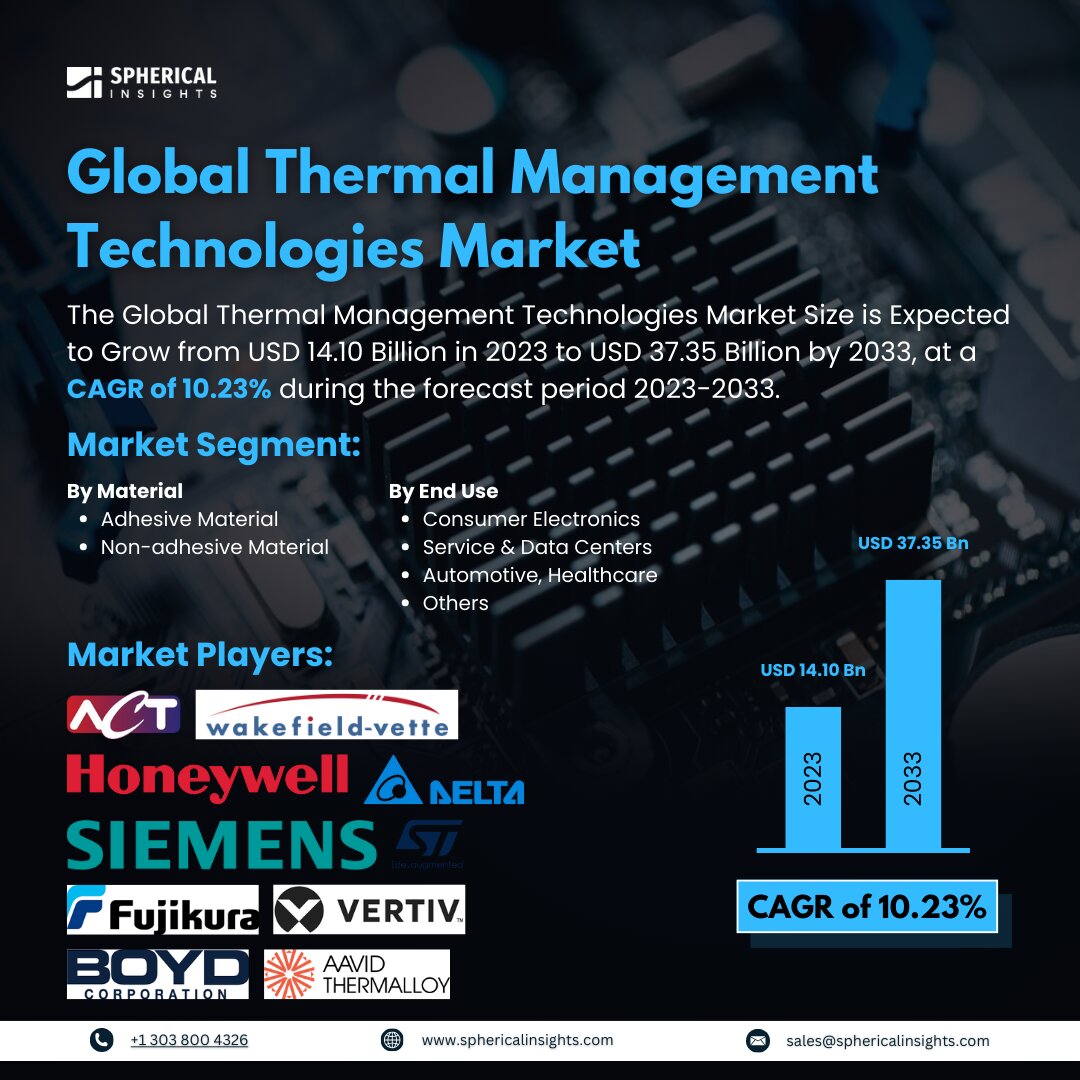Global Thermal Management Technologies Market Size to worth USD 37.35 Billion by 2033
According to a research report published by Spherical Insights & Consulting, the Global Thermal Management Technologies Market Size is Expected to Grow from USD 14.10 Billion in 2023 to USD 37.35 Billion by 2033, at a CAGR of 10.23 % during the forecast period 2023-2033.
Browse key industry insights spread across 210 pages with 110 Market data tables and figures & charts from the report on the Global Thermal Management Technologies Market Size, Share, and COVID-19 Impact Analysis, By Material (Adhesive Material and Non-adhesive Material), By End-Use (Consumer Electronics, Service & Data Centers, Automotive, Healthcare, and Others), and By Region (North America, Europe, Asia-Pacific, Latin America, Middle East, and Africa), Analysis and Forecast 2023 – 2033.
Thermal management technologies refer to the development, manufacturing, and application of solutions designed to manage heat within electronic and mechanical systems. These solutions include heat sinks, thermal interface materials, fans, heat pipes, and liquid cooling systems that are critical to maintaining optimal operating temperatures in computers, automobiles, industrial machinery, and consumer electronics. Effective heat dissipation prevents system failure, improves performance, and prolongs the lifespan of components. The main factors driving the market are high-performance electronic devices, advances in automotive technologies, and growth in renewable energy systems. A growing factor for this market is electric vehicle production, where high levels of thermal management for batteries and power electronics are necessary. Further growth factors include an expansion in data centers and a heightened need for electronics due to power consumption. However, the market faces challenges such as the high cost of advanced thermal management systems and the complexity of integrating these solutions into existing designs.
The non-adhesive material segment accounted for the largest share in 2023 and is expected to grow at a significant CAGR during the forecast period.
Based on the material, the thermal management technologies market is classified into adhesive material and non-adhesive material. Among these, the non-adhesive material segment accounted for the largest share in 2023 and is expected to grow at a significant CAGR during the forecast period. The dominance of this segment is primarily due to the wide range of applications and superior performance of non-adhesive materials in heat dissipation. These materials, such as copper, aluminum, graphite, and ceramics, are commonly used in heat sinks, thermal pads, and heat pipes due to their high thermal conductivity and durability.
The consumer electronics segment accounted for the largest share in 2023 and is expected to grow at a significant CAGR during the forecast period.
Based on the end use, the thermal management technologies market is divided into consumer electronics, service & data centers, automotive, healthcare, and others. Among these, the consumer electronics segment accounted for the largest share in 2023 and is expected to grow at a significant CAGR during the forecast period. The dominance of this segment is driven by the increasing demand for compact, high-performance electronic devices, including smartphones, laptops, tablets, wearables, and gaming consoles. As these devices become more advanced with greater processing power, the need for effective thermal management solutions to prevent overheating and ensure optimal performance becomes crucial.
North America is estimated to hold the largest thermal management technologies market share over the forecast period.
North America is estimated to hold the largest thermal management technologies market share over the forecast period. With more reliance on data centers for data storage, processing, and cloud services, the demand for effective thermal management solutions for high-density server environments in the region is rising. Advanced thermal management technologies like liquid cooling systems, heat sinks, and air-cooled systems are crucial for optimal operating temperatures, improved energy efficiency, and reliability of the system.
Middle East & Africa is predicted to have the fastest CAGR growth in the thermal management technologies market over the forecast period. Rising concern over energy efficiency and sustainability leads to the integration of thermal management technologies in the Middle East and Africa. Given the extreme climatic conditions and increasing environmental consciousness, the reduction of energy consumption and carbon emissions has become increasingly important in sectors such as manufacturing, automotive, and construction. The demand for energy-efficient cooling and heating systems, such as thermoelectric coolers, phase change materials, and heat recovery systems, is also on the rise.
Competitive Analysis
Major key players in the thermal management technologies market are Advanced Cooling Technologies, Inc., Delta Electronics, Inc., Honeywell International Inc., Siemens AG, STMicroelectronics, Fujikura Ltd., Boyd Corporation, Aavid Thermalloy, LLC, Vertiv Holdings Co, Wakefield-Vette, and Others.
Key Target Audience
- Market Players
- Investors
- End-users
- Government Authorities
- Consulting And Research Firm
- Venture capitalists
- Value-Added Resellers (VARs)
Market Segment
This study forecasts global, regional, and country revenue from 2023 to 2033. Spherical Insights has segmented the thermal management technologies market based on the below-mentioned segments:
Global Thermal Management Technologies Market, By Material
- Adhesive Material
- Non-adhesive Material
Global Thermal Management Technologies Market, By End Use
- Consumer Electronics
- Service & Data Centers
- Automotive, Healthcare
- Others
Global Thermal Management Technologies Market, By Regional Analysis
- North America
- Europe
- Germany
- UK
- France
- Italy
- Spain
- Russia
- Rest of Europe
- Asia Pacific
- China
- Japan
- India
- South Korea
- Australia
- Rest of Asia Pacific
- South America
- Brazil
- Argentina
- Rest of South America
- Middle East & Africa
- UAE
- Saudi Arabia
- Qatar
- South Africa
- Rest of the Middle East & Africa



